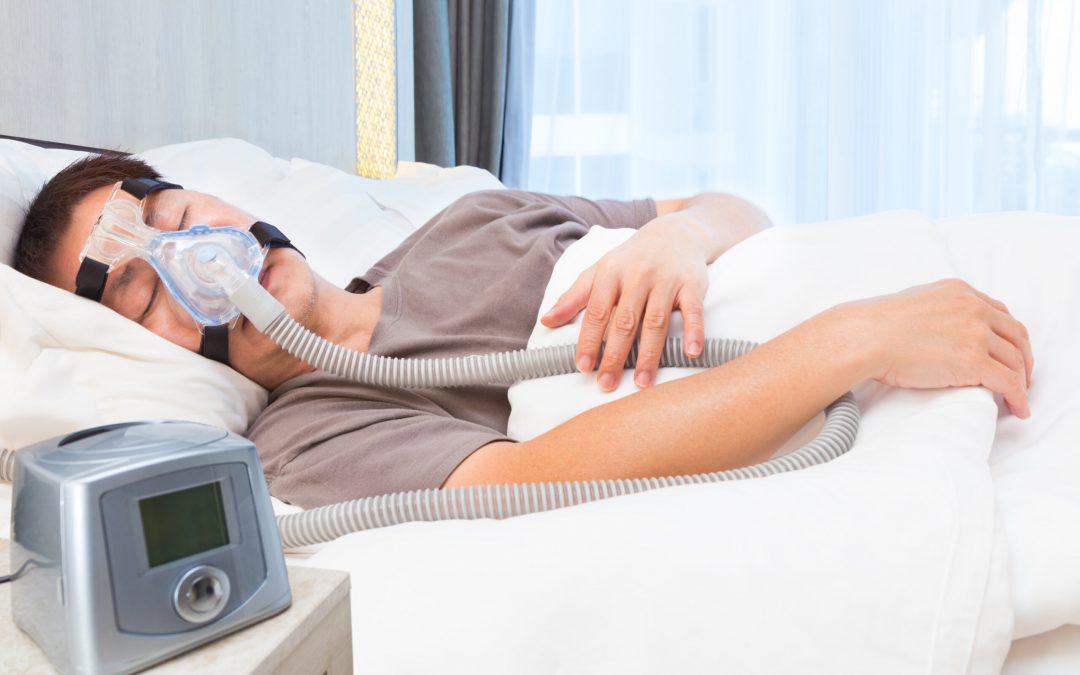Medical News Today Article by Eileen Bailey on October 4, 2023 — Fact checked by Michelle T. Wyatt, MD
People with cardiovascular disease and obstructive sleep apnea who used a continuous positive airway pressure (CPAP) device for four or more hours per day had a significantly lower risk of having a major adverse cardiac or cerebrovascular event, according to a studyTrusted Source published today in the journal JAMA.
A meta-analysis of three randomized clinical trials that included information on 4,186 individuals found that the adherent use of CPAP machines for obstructive sleep apnea significantly reduced major adverse cardiac or cerebrovascular events.
In the study, about 2,100 individuals received CPAP therapy and nearly 2,100 did not. Both groups received education on dietary changes to help manage weight and cardiovascular risk factors as well as sleep hygiene counseling.
“This is a meta-analysis of three randomized trials to determine if CPAP use reduces the risk of… cerebrovascular or cardiac event or death stemming from myocardial infarction, stroke, or hospital admission due to heart failure/angina (cardiac chest pain)/transient ischemic attack (TIA),” explained Dr. Margarita Oks, a pulmonologist at Northwell Lenox Hill Hospital in New York who was not involved in the study.
“The patient population this analysis focused on was those who have moderate to severe [obstructive sleep apnea] and established cardiovascular disease,” she told Medical News Today. “There wasno significant reduction in cardiovascular or cerebrovascular events in patients who used CPAP [in the initial three studies], but this may have been due to lower adherence of less than four hours per night. In an alternative analysis, those patients who used CPAP for four hours or more per night did have a significant reduction in cerebrovascular and cardiovascular events.”
The researchers note that the risk of cardiovascular recurrence was closely linked to adherence to CPAP treatment.
“This study re-emphasizes the adverse cardiovascular effects that are associated with untreated obstructed sleep apnea,” said Dr. Jim Liu, a cardiologist at The Ohio State University Wexner Medical Center who was not involved in the study.
“This can have harmful effects on the heart,” he explained to Medical News Today. “It could result in high blood pressure or make someone’s high blood pressure difficult to control. It can contribute to certain arrhythmias and elevated pressures in the heart. By using CPAP to treat sleep apnea, some of these heart conditions can be avoided, and high blood pressure may be more controlled.”
What happens during a sleep apnea episode
People with obstructive sleep apnea stop and restart sleeping many times at night. It occurs when the upper airway becomes blocked, leading to brief pauses in breathing, according to the Sleep Foundation.
While sleeping, muscles relax and cause partial or complete collapse and blockage of the upper airway.
“Sleep apnea, characterized by repeated interruptions in breathing during sleep, can have significant implications for heart health,” said Dr. Rigved Tadwalkar, a cardiologist at Providence Saint John’s Health Center in California who was not involved in the study.
“One of the primary ways sleep apnea affects the heart is by causing fluctuations in blood oxygen levels and increasing blood pressure,” he told Medical News Today. “During apnea episodes, when breathing temporarily stops or becomes shallow, oxygen levels in the blood drop, and the body responds by releasing stress hormones, such as epinephrine, to stimulate the heart and lungs.”
“These hormonal surges can lead to elevated blood pressure, both during apnea events and throughout the day, contributing to hypertension (high blood pressure),” Tadwalkar added. “Chronic hypertension is a well-established risk factor for heart disease, including conditions like heart attack and stroke.”
The connection between sleep apnea and heart disease
Obstructive sleep apnea can affect the heart in several ways. The frequent drops in low oxygen levels can damage the vessels that supply the heart, according to the American Thoracic Society.
The oxygen level drops, which can cause the heart to beat faster and blood pressure to rise. The stress on the heart can cause the heart to become enlarged.
“Furthermore, sleep apnea can be associated with disturbances in heart rhythm, known as arrhythmia,” Tadwalkar said. “The most common arrhythmia linked to sleep apnea is atrial fibrillation (A-fib). A-fib is an irregular and often rapid heartbeat that can increase the risk of stroke, heart failure, and other heart-related complications. The mechanisms linking sleep apnea and a-fib are not fully understood but likely involve the effects of intermittent hypoxia and sympathetic nervous system activation caused by apnea episodes.”
Experts note that there is also a cross-connection between heart disease and sleep apnea, each contributing to the other.
“The most important connection between sleep and heart health is the relationship with sleep apnea. Having untreated sleep apnea increases the risk of ischemic heart disease as well as heart failure, and heart failure, in turn, predisposes people to develop sleep apnea,” said Dr. Cheng-Han Chen, an interventional cardiologist and medical director of the Structural Heart Program at MemorialCare Saddleback Medical Center in California who was not involved in the study.
“In patients with sleep apnea, sleeping on the side will help keep the airway open compared to sleeping on the back,” Chen told Medical News Today.
Maybe it’s all about blood pressure
Not everyone agrees that obstructive sleep apnea causes a variety of problems. Some experts suggest that perhaps high blood pressure causes A-fib and blood vessel damage.
Using CPAP doesn’t treat the root of the problem, they note. Weight loss and lifestyle adjustments are better as long-term solutions.
“I don’t think this paper shows that this treatment reduces the risk of heart attack. I think that it sort of echoes the data we’ve had to date,” said Dr. Gregory Katz, a cardiologist at NYU Langone Heart and assistant professor in the Department of Medicine in the Leon H. Charney Division of Cardiology at NYU Grossman School of Medicine who was not involved in the study.
“CPAP treats symptoms rather than treating the underlying thing causing the disease,” he told Medical News Today. “But short-term studies have shown that lower blood pressure improves patients’ sleep quality and gives them improved rest overnight. Theoretically, this can benefit the patient and reduce cardiovascular events. However, I can’t recommend this to half my patients as an intervention to reduce their risk of heart attack or stroke. I can recommend to my patients to use this to improve their quality of sleep and improve their subjective quality of life quality of life because of better sleep.”
Treating obstructive sleep apnea
CPAP machines remain the standard treatment for obstructive sleep apnea. Other treatments include:
- Oral appliances to keep the soft tissue from collapsing
- Surgery to increase the size of the airway
- Weight loss
- Abstaining from alcohol and sedating medications
- Positional therapy to train the person to sleep on the side instead of the back
“Treatment for obstructive sleep apnea (OSA) depends on the severity of the disease. In general, PAP therapy can be used at any OSA severity,” Oks said. “Other options include mandibular advancement devices and hypoglossal nerve stimulation. Mandibular advancement devices are custom made by trained dentists. All treatment options have pros and cons associated with them and should be discussed with a sleep medicine physician.“
There are also some new treatments:
- Hypoglossal nerve stimulation (upper airway stimulation is done with an implanted pacemaker-like device, according to Duke Health. Three components are implanted – a sensor near the lungs to detect breathing patterns, a stimulator delivers mild signals to nerves that control your tongue, causing the tongue to move forward, and a pacemaker-like device to coordinate the stimulation of your breathing.
- An oral medication. Apnimed AD109 is a combination of atomoxetine and aroxybutynin that activates the upper airway muscles and keeps the airway open during sleep. It is currently in the fast track program for Food and Drug Administration approval.
Read the rest of this article here

